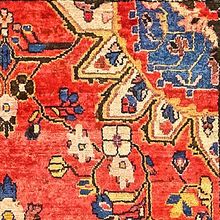Mehraban Rug
| Mehraban Rug | |
|---|---|
 Design of Mehraban Rug (Rugman) | |
| General information | |
| Name | Mehraban Rug |
| Original name | قالی مهربان |
| Alternative name(s) | Mehraban Carpet |
| Origin | |
| Category | Village |
| Technical information | |
| Common designs | Vagireh, Herati, Geometric |
| Common colors | Red, Blue, Navy Blue, Ivory, Brown, Beige, Yellow |
| Dyeing method | Natural, Synthetic |
| Pile material | Wool |
| Foundation material | Cotton |
| Knot type | Symmetrical (Turkish) |
History
Materials
Foundation and Pile
The foundation is made with cotton and the pile is made with wool.[1]
Techniques and structures
Color and dyeing
Mehraban rug fields generally are colored in a characteristic camel hair or peach that distinguishes the rugs from other Hamadan-area weavings. In addition to these two colors, shades of blue, red, green, gray, gold, brown, and black are used for the borders, design elements, outlines, and, at times, the background. The camel hair coloration is often used as a plain outer border in framing the carpet.[2]
Motifs and Designs
The rug designs have a geometric, village style featuring multiple medallions with tribal ornaments and, at times, animal and bird motifs. Other Mehraban designs include the tribal palmette, leaves, and vines.[3]
Weaving techniques
The foundation is tied in the Turkish (symmetric) knot. The grade qualities of the weavings are generally good to fine.[4]
See also
References
Bibliography
- Abraham Levi Moheban, (2015), The Encyclopedia of Antique Carpets: Twenty-Five Centuries of Weaving, NewYork: Princeton Architectural Press.